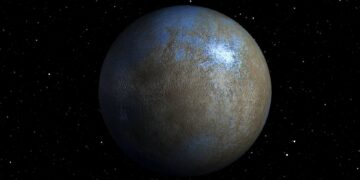The search for life beyond Earth has long been a driving force in planetary science. One of the most exciting aspects of this search is the discovery of organic molecules—the fundamental building blocks of life—on celestial bodies across our solar system. Scientists have now found these molecules on Ceres, a dwarf planet residing in the asteroid belt between Mars and Jupiter.
The Discovery of Organic Molecules on Ceres
Ceres has long fascinated scientists due to its unique location in the solar system, acting as a bridge between the inner rocky planets and the icy outer worlds. As a dwarf planet, Ceres is the largest object in the asteroid belt and has been known to possess water ice, suggesting it may have once hosted a subsurface ocean. The presence of water, combined with newly discovered organic molecules, makes Ceres a compelling subject in astrobiology.
The Dawn spacecraft, which orbited Ceres from 2015 to 2018, used a visible and infrared mapping spectrometer to scan the planet’s surface. This instrument allowed scientists to detect specific wavelengths of light that indicated the presence of aliphatic hydrocarbons—carbon-based compounds that form a key component of organic chemistry. These compounds were found near Ernutet crater, a 50-kilometer-wide impact site in Ceres’ northern hemisphere.
The significance of this discovery cannot be overstated. Organic molecules, particularly aliphatic hydrocarbons, are the precursors to more complex molecules like amino acids, which are necessary for life. While finding organics does not mean Ceres harbors life, it strongly suggests that the dwarf planet contains—or once contained—the raw materials for prebiotic chemistry.
The Origins of Ceres’ Organic Molecules: Local Formation or Cosmic Delivery?
Once scientists identified organic molecules on Ceres, the next big question was: Where did they come from? There are two main hypotheses:
- Endogenous Origin (Internal Formation): The organics could have formed within Ceres itself, emerging from geochemical reactions between water, rock, and heat in the planet’s interior.
- Exogenous Origin (External Delivery): The organics may have been brought to Ceres by asteroids or comets, depositing these life-building compounds through impacts.
Initially, many researchers believed Ceres’ cryovolcanic activity could be responsible. Cryovolcanism refers to the eruption of salty water, mud, or ammonia from a planet’s interior instead of molten rock. Since Ceres is known to have a subsurface reservoir of water, it seemed plausible that cryovolcanism could have brought organic molecules to the surface over millions of years.
However, a new study published in Nature Geoscience casts doubt on this assumption. Researchers analyzed Dawn’s spectrometer data using artificial intelligence to map all potential organic deposits. Surprisingly, they found that organic-rich sites were rare and not linked to any cryovolcanic features. In other words, the locations where organic compounds were detected did not overlap with areas where subsurface water or volcanic activity was present.
Instead, scientists now lean toward the theory that asteroids from the outer asteroid belt delivered the organic materials to Ceres. Simulations suggest that asteroids rich in carbon compounds frequently collide with Ceres at low speeds, preventing excessive heat from destroying the organics upon impact. This means that rather than originating from within, these molecules may have hitched a ride on cosmic debris billions of years ago.
Why Is This Discovery Important?
1. Reinforcing the Theory of Panspermia
One of the most intriguing theories in astrobiology is panspermia, which suggests that life’s building blocks can travel across the solar system via asteroids and comets. The discovery that Ceres’ organics may have been delivered by asteroid impacts strengthens this idea. If these compounds could survive an impact and remain stable on Ceres, similar processes might have seeded Earth, Mars, and other planets with life’s essential ingredients.
2. Expanding the Habitability Zone
Traditionally, scientists believed that the habitable zone—the region around a star where liquid water can exist—was limited to Earth-like planets. However, discoveries like those on Ceres, Europa, and Enceladus suggest that life-friendly conditions may exist beyond this zone, even on icy worlds and dwarf planets.
The presence of water ice and organic material makes Ceres a candidate for habitability, at least in its distant past. This forces scientists to redefine the conditions under which life might emerge.
3. Implications for Mars and Other Celestial Bodies
Ceres is not the only place where organic compounds have been detected. Mars, Saturn’s moon Titan, and the asteroid Ryugu have also shown traces of organics. Studying these compounds across different celestial bodies helps scientists compare how organic chemistry evolves in diverse environments. If similar processes are found across multiple objects, it strengthens the argument that the ingredients for life are widespread in the universe.
What Comes Next? Future Exploration of Ceres
While the Dawn mission provided groundbreaking data, it could not directly sample Ceres’ surface. To truly understand the nature of these organic molecules, scientists are calling for a future lander mission to explore Ceres more closely.
A Ceres Sample Return Mission would allow scientists to physically analyze organic materials in a laboratory setting, identifying their precise chemical composition and origin. Such a mission could answer critical questions:
- Are the organics on Ceres similar to those found in meteorites on Earth?
- Could prebiotic chemistry have occurred on Ceres?
- Is there still ongoing geological activity beneath the surface?
Conclusion: Ceres and the Cosmic Recipe for Life
The discovery of organic molecules on Ceres represents one of the most exciting advancements in planetary science. Whether these compounds formed on Ceres or arrived via asteroid impacts, they provide strong evidence that organic chemistry is common throughout the solar system.
Reference:



















